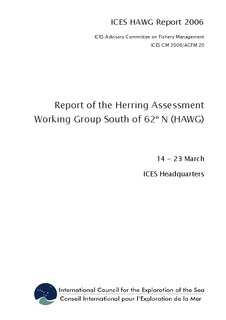| dc.contributor.author | ICES | |
| dc.date.accessioned | 2007-07-26T08:00:48Z | |
| dc.date.issued | 2006 | |
| dc.identifier.uri | http://hdl.handle.net/11250/102108 | |
| dc.description | Contributors: Dankert W. Skagen, Else Torstensen | |
| dc.description.abstract | The ICES herring assessment working group (HAWG) met for 10 days in March 2006 to
assess the state of 7 herring stocks and 3 sprat stocks. New data were only available for 6
herring stocks and 2 sprat stocks. HAWG carried out a benchmark assessment on North Sea
herring. The following issues were explored:
• catch data through catch curves
• survey data based assessments using SURBA
• simpler models using CSA
• standard catch at age assessment models (ICA, XSA and FLICA, FLXSA in R)
• time inconsistencies, outliers and time trends in indices.
• retrospective performance of the different models.
The exploration resulted in ICA being chosen again as the principle model for the assessment
of North Sea herring. HAWG also truncated the IBTS and MIK time series used in the model
and adjusted the weighting factors on the catch and surveys. These changes lead to improved
precision in the estimates of F and SSB in the terminal year and reduced retrospective bias in
the assessment. The changes did not greatly change the perception of the state of the stock
compared to last year’s assessment or compared to an assessment with last years model
settings.
The recent trends in North Sea autumn spawning herring show a peak in spawning biomass
(SSB) of 1.8 million tonnes in 2004 and the SSB is now likely to decline due to serial poor
recruitment since 2001. The new recruitment estimate for 2006 is again well below average.
This poor recruitment is caused during the larvae phase of North Sea herring.
Update or exploratory assessments were carried out on all the other stocks. Two assessments
were offered for herring to the west of Scotland (as a very low acoustic survey estimate had a
marked effect on the assessment). Both IVaS and Celtic Sea herring had their time series of
acoustic surveys revised. The assessments suggest that both of these stocks are at historic low
spawning biomass. The assessment of IIIa was updated, and HAWG then spent much time
improving the clarity of the IIIa advice.
HAWG answered one special request from the EU on the TAC for North Sea sprat in 2006.
Sprat in the North Sea appears to be at a high biomass in recent years, but the incoming 2006
year class appears to be well below the average.
HAWG also commented on the quality and availability of data, the problems with estimating
the amounts of discarded fish, the relevance of ecosystem changes to the stocks considered by
the group and recent meetings and reports of relevance to HAWG.
HAWG was concerned about the apparent increase in misreporting of catches in recent years
and the growing relaxation of regulations designed to restrict the ability to misreport or catch
herring as bycatch. | en |
| dc.format.extent | 16967606 bytes | |
| dc.format.mimetype | application/pdf | |
| dc.language.iso | eng | en |
| dc.publisher | ICES | en |
| dc.relation.ispartofseries | ICES CM documents | en |
| dc.relation.ispartofseries | 2006/ACFM:20 | en |
| dc.subject | sprat | en |
| dc.subject | brisling | en |
| dc.subject | herring | en |
| dc.subject | sild | en |
| dc.title | Report of the Herring Assessment Working Group South of 62° N (HAWG) | en |
| dc.type | Research report | |
| dc.source.pagenumber | 618 s. | en |
